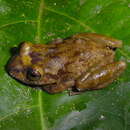Description
provided by AmphibiaWeb articles
This species is a member of the subgenus Eleutherodactylus. Its dorsal surface is metallic tan, brown or sometimes green, and stippled or flecked with dark brown. Some specimens have an unmarked dorsum that is uniformly tan or brown. Often there is a poorly defined dark papilonaceous interocular figure and a pale interocular bar. The concealed surfaces of the hind limbs are gray. The venter is faintly yellowish, especially on the vocal sac. The canthus rostralis is straight and a distinct canthal bar is present. The body is flattened and the head is as wide as the body. There is no webbing between the toes. The digital disks are large and conspicuous. The vomerine teeth, behind the coanes, are in short series. The chromosome number is 26. Adult size is moderate, reaching 40 mm in females and 30 mm in males (Schwartz 1960; Schwartz and Henderson 1991; Hedges et al. 1992).Related species- E. varians, E. guantanamera, E. melacara Synonyms- Eleutherodactylus varians ionthus Schwartz, 1960
Distribution and Habitat
provided by AmphibiaWeb articles
This species is endemic to Cuba and it is known only in the Sierra Maestra Mountains in Eastern Cuba. It is an arboreal frog and it occurs in a variety of habitats, including mesic and xeric forests, coffee plantations, cultivated fields and disturbed vegetation around towns and cities.
Life History, Abundance, Activity, and Special Behaviors
provided by AmphibiaWeb articles
These frogs are typically found in tree canopies more than 2 meters from the ground. During the day it retreats to bromeliad leaf-bases. By night, males vocalize from branches, often covered with dense stands of epiphytes, and leaves. Calls are composed of 1-3 loud and metallic notes that reverberate in the trees, with the dominant frequency between 2.4 and 2.8 kHz. This frog is a direct developing species. Clutches are deposited within moist leaf-bases of bromeliads (Schwartz and Henderson 1991, Fong, personal observation).
Eleutherodactylus ionthus: Brief Summary
provided by wikipedia EN
Eleutherodactylus ionthus is a species of frog in the family Eleutherodactylidae endemic to Cuba. Its natural habitats are subtropical or tropical moist lowland forest and subtropical or tropical moist montane forest. It is threatened by habitat loss.
- license
- cc-by-sa-3.0
- copyright
- Wikipedia authors and editors

